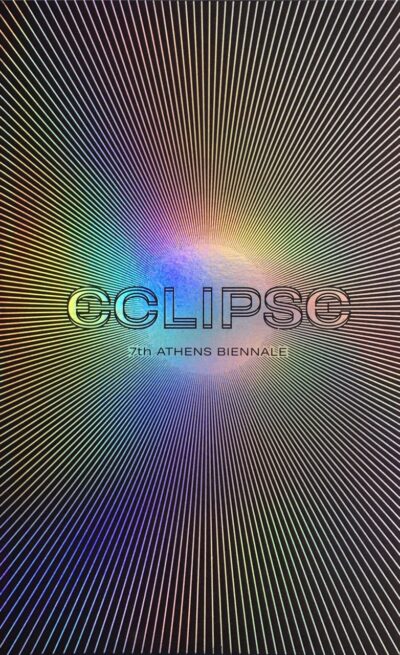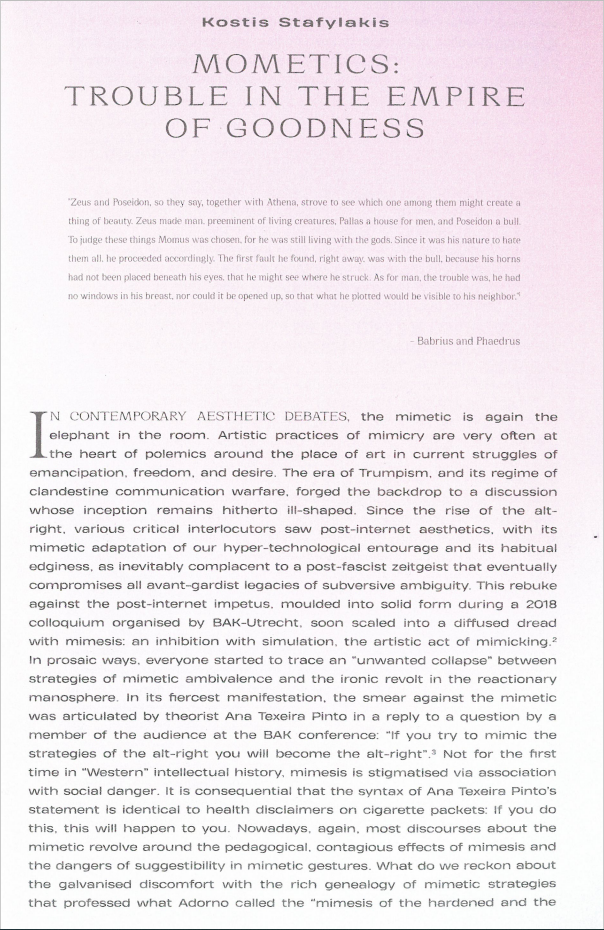Mometics @ 7th Athens Biennale Catalogue

Kostis Stafylakis, "Mometics: Trouble in the Empire of Goodness", published at the 7th Athens Biennale Catalogue, September 2021.
Wrote this to introduce the notion of Mometics, a term I coined to acknowledge the relation between the Mime and Momus (God of satire, mockery, and unfair judgement). I attempt to examine the relevance of their constitutive overlapping for mimetic theory, post-internet aesthetics, and contemporary politics. Read the text here

An excerpt:
Mometics: Trouble in the Empire of Goodness
‘Zeus and Poseidon, so they say, together with Athena, strove to see which one among them might create a thing of beauty. Zeus made man, preeminent of living creatures, Pallas a house for men, and Poseidon a bull. To judge these things Momus was chosen, for he was still living with the gods. Since it was his nature to hate them all, he proceeded accordingly. The first fault he found, right away, was with the bull, because his horns had not been placed beneath his eyes, that he might see where he struck. As for man, the trouble was, he had no windows in his breast, nor could it be opened up, so that what he plotted would be visible to his neighbor. […]’1
Babrius and Phaedrus
In contemporary aesthetic debates, the mimetic is again the elephant in the room. Artistic practices of mimicry are very often at the heart of polemics around the place of art in current struggles of emancipation, freedom, and desire. The era of Trumpism, and its regime of clandestine communication warfare, forged the backdrop to a discussion whose inception remains hitherto ill-shaped. Since the rise of the alt-right, various critical interlocutors saw post-internet aesthetics, with its mimetic adaptation of our hyper-technological entourage and its habitual edginess, as inevitably complacent to a post-fascist zeitgeist that eventually compromises all avant-gardist legacies of subversive ambiguity. This rebuke against the post-internet impetus, moulded into solid form during a 2018 colloquium organised by BAK-Utrecht, soon scaled into a diffused dread with mimesis: an inhibition with simulation, the artistic act of mimicking.2 In prosaic ways, everyone started to trace an “unwanted collapse” between strategies of mimetic ambivalence and the ironic revolt in the reactionary manosphere. In its fiercest manifestation, the smear against the mimetic was articulated by theorist Ana Teixeira Pinto in a reply to a question by a member of the audience at the BAK conference: “If you try to mimic the strategies of the alt-right you will become the alt-right”.3 Not for the first time in “Western” intellectual history, mimesis is stigmatised via association with social danger. It is consequential that the syntax of Ana Teixeira Pinto’s statement is identical to health disclaimers on cigarette packets: If you do this, this will happen to you. Nowadays, again, most discourses about the mimetic revolve around the pedagogical, contagious effects of mimesis and the dangers of suggestibility in mimetic gestures. What do we reckon about the galvanised discomfort with the rich genealogy of mimetic strategies that professed what Adorno called the “mimesis of the hardened and the alienated”? What happens with the numerous mimetic strategies in late and post-socialist, post-modern, late-liberal, and post-truth eras?What do we salvage from terms such as exacerbated mimesis, subversive affirmation, unsettling mimesis, disjointed mimesis, mimetic critique, parafiction, overidentification?
In this text, I wish to problematise the shadow-ban of the mimetic. This is because I still aspire to the mimetic as a sine qua non of the desiring subject – in sync with a Lacanian theory of semblance (le semblant) that does not oppose mimetic constructs to reality, but sees semblance as that which conditions language and the production of truth; and because I don’t see artistic semblances predominantly as subversive achievements but as valuable entanglements in the performative priority of the world. But mostly I wish to propose that contemporary mimetic theory, upgraded today by extraordinary breakthroughs, can chart the cultural and political ripple effects of the mimetic only by introducing a second or third term, entirely intertwined with the history of mimesis: the mometic. I suggest revisiting the ever-present, ever-shifting, and timely personifications of Momus in intellectual history, in his pas de deux with the mime. From his birth in Hesiod and Aesop to the Italian Renaissance and the Reformation, Momus is the god of blame, mockery, satire, son of Night, god of writers, poets, censure and unfair criticism, the ancient “troll” according to a blogger, the Ur-Critic of the divine, the ambiguous personification of both parrhesia and resentment, or of the slippage between the two; a disruptive power so fundamental to the birth of early-modern literature that emanated as a Luciferian critic of the divine creation in Milton and as the true critic of modern literature in Jonathan Swift. With his Doubting the Divine in Early Modern Europe: The Revival of Momus, the Agnostic God (2018), George McClure offered an enchanting account of Momus’ intellectual legacy, showing that malicious trolling is not a very young science;4 it was invented neither by millennial lulz, nor by ’90s “ironic” cartoons. I will use McClure’s key to see whether I can unlock the mechanics behind this idea: this labour of tracking Momus in mimesis, of recognising Momus under the guise of the mime, of identifying the mometic in the mimetic. This task is what I call “mometics”. Mometics is a method of thinking with the “problem”, of “walking with the enemy”, of reserving some room for Momus. This shift to the mometic is also a step away from the evolutionary background of the notion of the “meme” and the memetic, so dominant in this debate. As McClure warns, in both the classical and modern world, Momus assumes both roles: “at times a reasonable, skeptical challenge to the unworthy; at other times an unreasonable, resentful assault of the worthy”.5 It is thus rudimentary to say that I see no innate force of emancipation in Momus. Just as nothing naturally emancipatory characterises either the mimetic or the mometic.
Read the rest of the text here